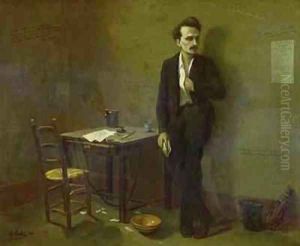Armand Gautier Paintings
Armand Gautier was a French painter and lithographer born on December 10, 1825, in Lorient, France. He was known primarily for his genre scenes, portraits, and historical paintings. Despite not being as widely recognized as some of his contemporaries, Gautier's work reflects the artistic movements of the 19th century and the influence of Romanticism and Realism.
Armand Gautier studied at the École des Beaux-Arts in Paris under the tutelage of Léon Cogniet, a prominent French historical and portrait painter. Gautier's education and early work were rooted in the academic traditions of the time, which emphasized classical subjects and techniques. However, Gautier also showed an interest in painting modern life and everyday scenes, which was a hallmark of the emerging Realist movement.
Throughout his career, Gautier exhibited at the Paris Salon, an official art exhibition of the Académie des Beaux-Arts in Paris, which was the most important annual and biennial art event in the Western world at the time. His participation in the Salon helped to establish his reputation as a painter. Gautier's works were also shown at the Exposition Universelle, an international exposition that took place in Paris.
Gautier's paintings are characterized by their detailed depiction of figures and a keen interest in capturing the nuances of light and shadow. His portraits often convey a sense of the sitter's character and personality, while his genre scenes provide a glimpse into the lives of the people of his era. Gautier's work can be seen as a bridge between the grand historical narratives of earlier 19th-century art and the more intimate, personal subjects that became popular later in the century.
Armand Gautier's contributions to French art were recognized in his time, but he did not achieve the level of fame of some of his contemporaries. However, his work remains appreciated by art historians and collectors for its craftsmanship and its place within the broader context of 19th-century French painting. Gautier passed away on August 1, 1894, in Plessis-Piquet (now Le Plessis-Robinson), a commune in the southwestern suburbs of Paris. Today, his works can be found in museum collections and are occasionally featured in exhibitions focusing on the period.



